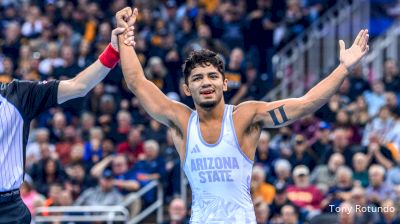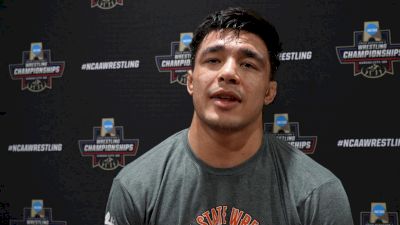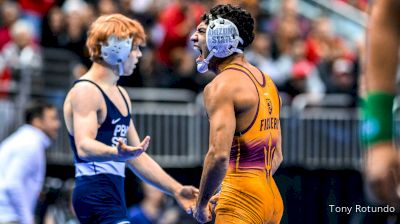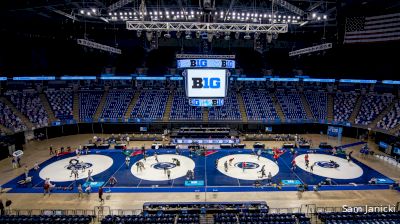What Does The Latest Round Of Conference Realignment Mean For Wrestling?
What Does The Latest Round Of Conference Realignment Mean For Wrestling?
The latest round of conference reshuffling sent ripples across the college athletics landscape, and it figures to impact wrestling in the months ahead.
A B1G bombshell dropped Thursday when UCLA and USC uprooted themselves from the Pac-12 and bolted for the Big Ten.
The latest round of conference reshuffling sent ripples across the rapidly changing college athletics landscape, and even though no wrestling programs are directly involved — yet — it figures to impact the sport on some level in the months ahead.
What Does This Mean For Big Ten Wrestling?
Thursday’s news fueled immediate speculation about the possibility of UCLA and USC launching wrestling programs upon arrival into the Big Ten. Though all 14 of the conference’s current institutions sponsor the sport, wrestling is not mandated by the league for member status.
“It’s my understanding there is no requirement of the Big Ten schools to have wrestling,” National Wrestling Coaches Association executive director Mike Moyer said. “That’s really a myth that’s out there.”
Moyer has seen upwards of 300 new programs join the college ranks since 2000, nearly all of which have been launched by smaller schools looking for an enrollment bump.
“Those Power Five schools, generally speaking, are not struggling for enrollment,” he said, “so it’s a real cost.”
And the price tag is massive. In discussions with other Power Five schools about the possibility of adding wrestling, Moyer has typically heard a similar starting dollar figure — $20 million — that wrestling backers need to bring to the table.
“What that’s essentially saying is (you have to) guarantee the funding of the program in perpetuity and it’s not going to require the athletic department to drain resources from any of its existing programs — that’s generally what we hear when we approach a school of that caliber,” Moyer said. “Remember, an endowment yields 5 percent, so off $20 million that would be $1 million (annually to operate the program) and that would put you in the neighborhood.”
But that doesn’t account for the gender equity piece of the equation. In all likelihood, it would take something in the range of an additional $20 million to fund either a women’s wrestling program or to add another women’s sport to solve for Title IX compliance.
“It’s not as if (UCLA and USC are moving to the Big Ten) to spend money, so it’s probably status quo,” Stanford coach Rob Koll said. “It’s hard to add a men’s team. If you’re an athletic director, why would you add a wrestling team unless you really like the sport or unless there’s a lot of active wrestling alumni? And there aren’t because they’ve never had a team at USC and haven’t had one in a long time at UCLA.”
But Koll also pointed out one thing wrestling has working in its favor in this instance — the move-in ready conference home that the Big Ten could offer. Moyer has said finding conference landing spots has been challenging for wrestling in past attempts to add major college programs, which clearly wouldn’t be a problem in the Big Ten.
“If there was ever going to be an opportunity to get a Power Five school to add wrestling — the Big Ten Conference, obviously, wrestling has been wildly successful — I would say on the surface, if we were ever going to have a chance, this would be it under these circumstances,” Moyer said. “But there’s a lot of fiscal pressures that even Power Five schools are dealing with today, so it remains to be seen.”
What’s Next For The Pac-12?
Pac-12 wrestling stabilized itself during the past year after the league found itself on shaky footing. As recently as 15 months ago, Stanford wrestling was on the chopping block and other conference coaches were contemplating whether latching on with another league, such as the Big 12, might be the best path forward for Pac-12 wrestling.
“If we say we’re done with it — because we’ve had that discussion — what if the world changed in 30 years or 40 years and USC wanted to add wrestling? Or UCLA? Or Washington?” Arizona State coach Zeke Jones said last spring. “Well, then there’s no Pac-12 wrestling, so why add it?”
Pac-12 wrestling stuck together, Stanford reinstated its program and the league had a banner year this past season with four squads — Arizona State, Oregon State, Stanford and wrestling affiliate Cal Poly — finishing inside the top 25 at the NCAA Championships.
But conference realignment has been driven by big-money television deals generated by football powerhouses in major media markets, and Olympic sports get taken along for the ride. So when the Pac-12 lost two of its centerpiece institutions last week, it put the rest of the conference on high alert.
The Pac-12’s media rights deals expire in 2024 and the loss of UCLA and USC could cost the conference $200 million per year, estimates former Fox Sports Networks president Bob Thompson.
The Pac-12 issued a statement last week that said its board of directors has “authorized the conference to explore all expansion options.” But while the league is looking to add, Pac-12 staples Oregon and Washington reportedly reached out to the Big Ten to check the temperature on leaping alongside UCLA and USC. Reports have also surfaced that Arizona, Arizona State, Colorado and Utah will meet Tuesday with the Big 12.
“If you read the different articles,” Koll said, “there’s a thousand hypotheses and opinions about which way this is going to go.”
If the Sun Devils bolt for the Big 12, it almost certainly will set off another series of discussions about the best path forward for Pac-12 wrestling.
“We can spend a lot of time speculating on what may or may not happen,” Moyer said. “The important thing for the wrestling community is to really focus on the things we have control over — making wrestling relevant in the school, in the community, making sure we do well by the new academic component to the revenue share, the APR, building strong relationships between coaches and administrators, focusing on those things and bringing as much value to the universities as we possibly can.”
Related Content
 Richie Figueroa | The Bader Show (Ep. 411)
Richie Figueroa | The Bader Show (Ep. 411)Apr 11, 2024
 Trey Munoz After Placing Third At The 2024 NCAA Tournament
Trey Munoz After Placing Third At The 2024 NCAA TournamentMar 24, 2024
 Shane Griffith Reflects On His Career After Third Place Finish
Shane Griffith Reflects On His Career After Third Place FinishMar 24, 2024
 Stephen Little After Becoming Little Rock's Second All-American In Program History
Stephen Little After Becoming Little Rock's Second All-American In Program HistoryMar 24, 2024
 Daniel Cardenas Celebrates With Team After Defeating Shapiro
Daniel Cardenas Celebrates With Team After Defeating ShapiroMar 22, 2024
 Kyle Parco Refocused This Season And Ready To Pursue An NCAA Title
Kyle Parco Refocused This Season And Ready To Pursue An NCAA TitleMar 22, 2024
 Daniel Cardenas After Defeating Meyer Shapiro Again
Daniel Cardenas After Defeating Meyer Shapiro AgainMar 22, 2024
 Cohlton Schultz Defeats Taylor To Make The Semifinals
Cohlton Schultz Defeats Taylor To Make The SemifinalsMar 22, 2024
 125 lb Quarterfinal, Richie Figueroa, Arizona State vs Braeden Davis, Penn State
125 lb Quarterfinal, Richie Figueroa, Arizona State vs Braeden Davis, Penn StateMar 22, 2024
